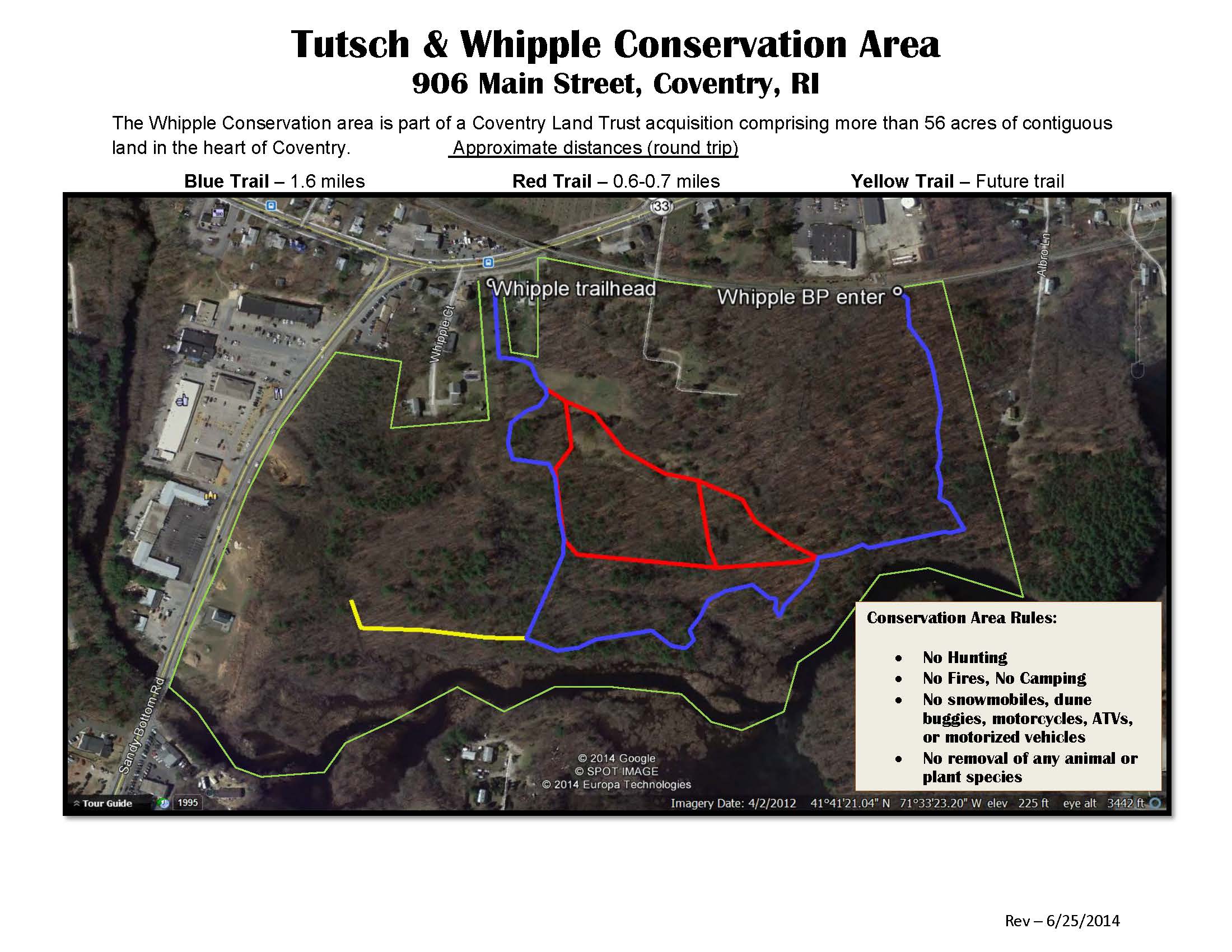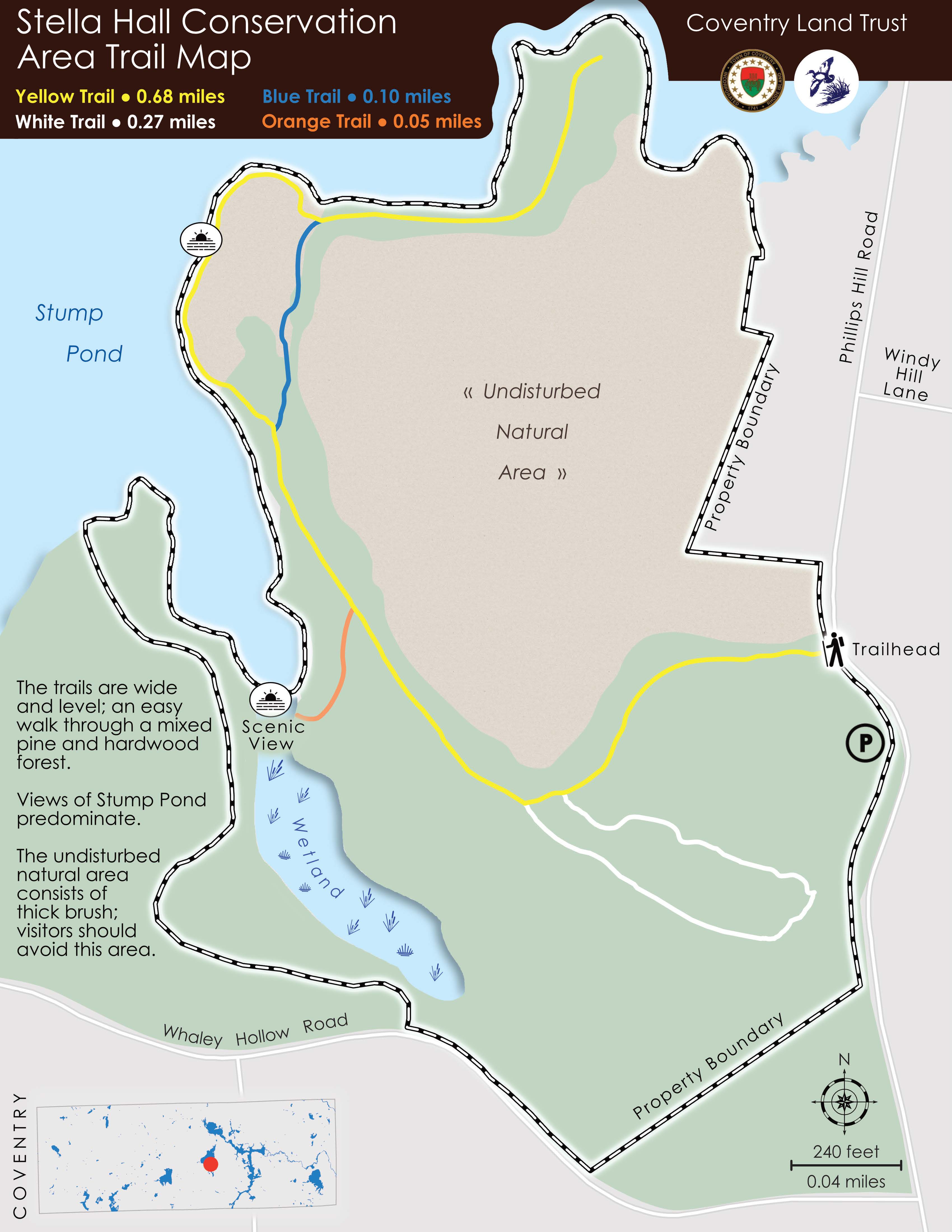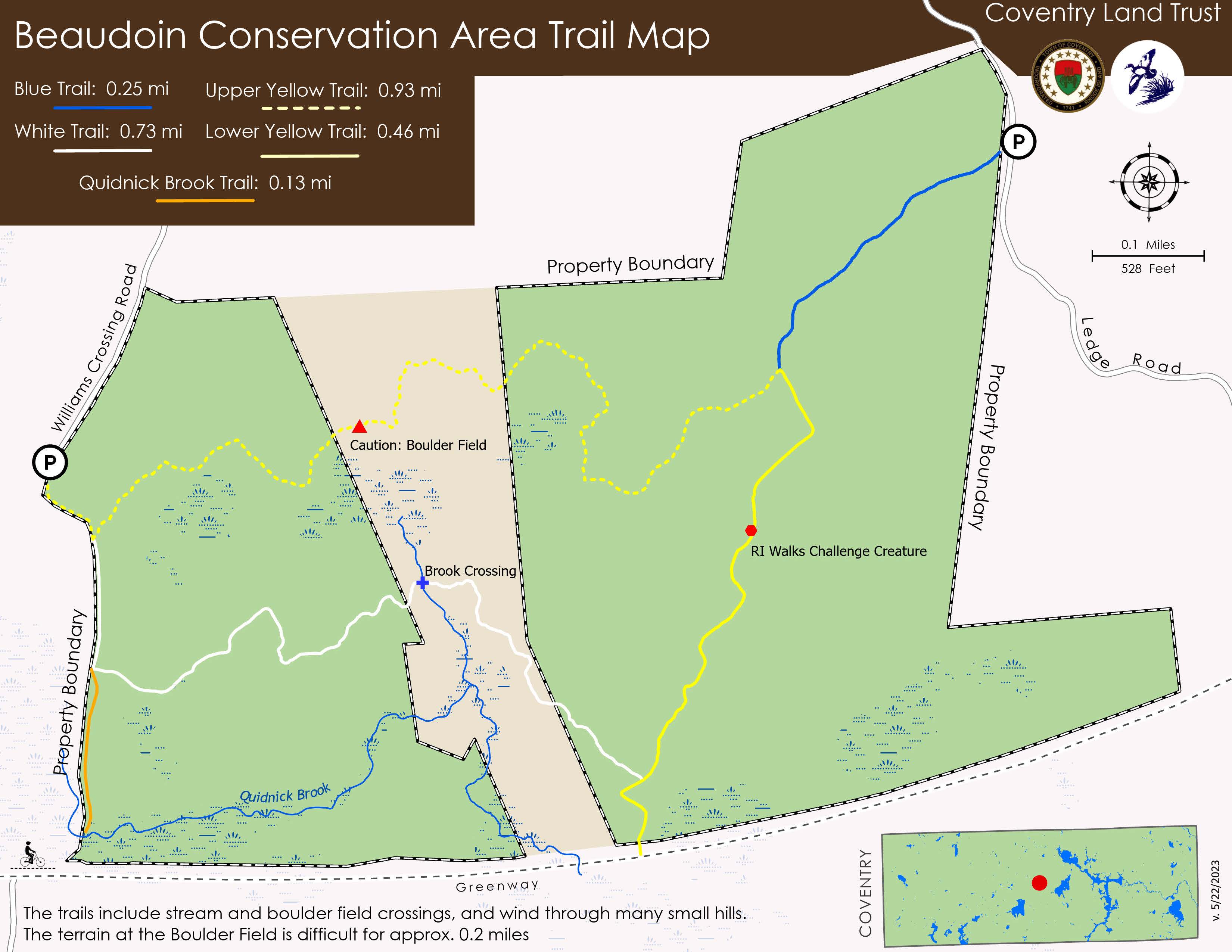Devoted to Preserving Coventry's Open Space
About the Land Trust: The Coventry Land Trust promotes the preservation of Coventry’s rural, rustic, and historic character. Members of the Land Trust are volunteers, appointed by the Town Council, to preserve open space, protect wetlands, water bodies, ground and surface water resources, farmlands, historical or cultural places of interest, scenic views, and unusual, exceptional, or exemplary natural habitats. The Land Trust was established by the Coventry Town Council in conjunction with the Rhode Island Legislature in 1999,
Our Mission:
- Acquire, preserve, and protect Coventry’s open space for future generations
- Conserve and protect environmentally sensitive lands and natural resources
- Educate residents and the general public regarding the need for land and resource conservation
- Recommend to the Town Council those properties which meet the goals and objectives for land preservation
Properties Available for Hiking:
Please report any damage or need for maintenance (downed trees, etc.) to the Town of Coventry Associate Planner, 401-822-6230.
Merrill S. Whipple Property - 906 Main Street (AP 46 Lots 37, 46.28.1 and 29): This property can be accessed from Route 117 just west of its intersection with Sandy Bottom Road. The sign for the Whipple Property is visible from the road. This tract includes over 50 acres of land and provides access to the Pawtuxet River and the Coventry Greenway. With its combination of deciduous forest and wetlands, it protects a diverse and unique biological habitat. Comprised of several parcels purchased by the town between 2000-2003, it was the first property acquired by the Land Trust. Click on image below to enlarge map. Also, please enjoy the drone footage video provided below.
Ruzzo/Stella Hall: (AP 318 Lot 204.2) This property can be accessed through a parking lot on Phillips Hill Road about 600 feet south of Whaley Hollow Road. It is comprised of 71 acres of open space, purchased by the town in 2007, adjacent to Stump Pond and the Greenway. For drone footage of the trail click HERE!
Click on image below to enlarge map.
Beaudoin Conservation Area: (AP 317 Lots 71 and 84) This property can be accessed from Ledge Road and Williams Crossing Road. It contains 175 acres abutting the greenway and near Stump Pond. Quidneck Brook, a habitat for wild brook trout, runs through the property. Beaudoin Conservation Area was purchased through a matching grant through RI DEM. Click on image below to enlarge map.
Janice L. Sullivan Conservation Area: To access this property, take Route 117 in Coventry to Stone Gate Drive. Follow Stone Gate until you reach Bramble Bush Road. Turn Right onto Bramble Bush and go to the end of the road to the Janice L. Sullivan Conservation Area. Parking is available at the trail head. The Conservation Area has a half-mile trail leading through a meadow and upland woodlands. It connects with the more extensive trails of the Beaudoin Conservation Area. Together these two properties protect over 250 acres of land.
This property was acquired by the Coventry Land Trust and the RI DEM. It is named in honor of a beloved educator and principal at Western Coventry School. Click on image below to enlarge map.
Easements and Development Rights: The Land Trust has also protected over 200 acres of land through Conservation Easements and the purchase of Development Rights. Click below to find out more about these programs.
Property Donations: Landowners are in a unique position to contribute to the Land Trust in numerous ways - by donation, or selling development rights, or placing conservation easements on the property. In many cases, property owners may receive substantial tax benefits for such donations.
The Land Trust is presently looking for new properties to preserve by continually exploring the use of conservation easements, development rights, grants, donations or outright purchase of land in an effort to protect Coventry’s natural character, farms, forests, and open space.
Conservation Easements: Easements are restrictions landowners voluntarily place on their property that legally bind the actions of present and future owners of the property to protect its associated resources. The rights the owner relinquishes and those he or she retains are set forth in a legal document, known as a conservation easement.
Each conservation easement must be specifically designed for a particular piece of property with its unique natural characteristics in mind. The specific rights retained by a landowner or restricted by easement vary with each property.
Conservation easements can be used to preserve wildlife habitat, open space, agricultural land, or the historic features of a building or site, while allowing the landowners to continue owning and using the property. These easements are recorded with the deed in the town’s land evidence records.
Conservation Easements are one of the most powerful and effective land protection tools available to landowners to protect land permanently while keeping it in private ownership and are among the fastest growing methods for the permanent conservation of private lands in the United States today.
These types of easements are designed to conserve forever important resource values of the property or the whole property. It is legally binding and must be monitored and enforced by a qualified conservation organization or governmental agency. The easement is either voluntarily donated or sold by the landowner and constitutes a legally binding agreement that limits certain types of uses or prevents development from taking place on the land in perpetuity while the land remains in private hands.
Conservation easements protect land for future generations while allowing owners to retain many private property rights and to live on and use their land, at the same time potentially providing them with tax benefits.
Development Rights: Current concerns over the rapid and increasing loss of farmland has led to the exploration of ways to protect our valuable resources. One of several options being considered is the acquisition or transfer of development rights. Development Rights are rights that a property owner holds to build on their property. Development rights may be sold or transferred. As a tool for preservation, Development Rights are often purchased by a group that has an interest in preventing development. A Land Conservation Trust may purchase the development rights for a farm that is in a desirable location for building.
News:
https://ecori.org/stella-hall-conservation-area-offers-unique-habitats-in-one-special-place/
https://ecori.org/species-of-lichen-discovered-in-unusual-habitat-in-coventry/
Contact Us: To report any damage or need for maintenance (downed trees, etc.), please call 401-822-6246 or email jchase@coventryri.gov.



